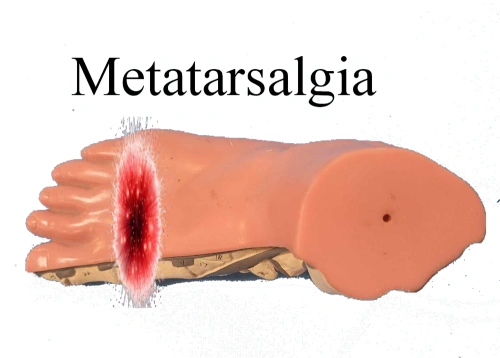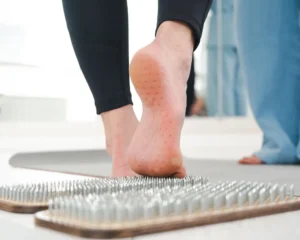It’s important to prioritize comfort and support in your footwear if you’re dealing with metatarsalgia. This common condition can cause significant discomfort in the ball of your foot, but making informed choices about your shoes can make a world of difference. In this guide, you’ll discover seven key steps to enhance your footwear, ensuring that your feet receive the relief they need while minimizing pain and promoting overall foot health. Let’s probe into practical strategies to help you step confidently and comfortably.
The Anatomy of Metatarsalgia: Understanding the Pain

Metatarsalgia refers to the pain and inflammation that occurs in the ball of your foot, specifically affecting the metatarsal bones. This discomfort often arises due to excessive pressure or overload on the metatarsals, resulting in localized pain that can negatively impact your daily activities. Recognizing the anatomy involved helps you understand the underlying factors that contribute to this condition, guiding you toward effective treatments and preventive measures.
Identifying the Symptoms
You may notice a sharp, aching, or burning pain in the ball of your foot, which can worsen when walking, standing, or wearing shoes. Symptoms often include swelling, a feeling of having a pebble in your shoe,(Motor’s Neuroma) and increased sensitivity in the affected area. These signs are crucial to pinpointing metatarsalgia and finding suitable relief.
Common Causes of Metatarsalgia
Several factors can contribute to metatarsalgia, including high-impact sports, ill-fitting footwear, and specific foot structures. High heels or shoes with inadequate cushioning can exacerbate the condition, while activities that place excessive stress on the metatarsals, such as jogging or repeated jumping, can also lead to inflammation and pain.
In many cases, improper footwear significantly heightens your risk for metatarsalgia. Shoes that lack arch support or cushioning put undue pressure on the metatarsals, making them more vulnerable to injury. Additionally, foot deformities—like bunions or hammer toes—can alter your weight distribution, leading to further discomfort. Understanding these factors is necessary in taking proactive steps to improve your footwear and lifestyle, fostering a more comfortable walking experience.
Footwear Features That Alleviate Discomfort
Choosing the right footwear is pivotal for managing metatarsalgia. Features such as cushioning, arch support, and adequate toe box space can significantly alleviate discomfort. Shoes designed with these elements not only provide relief but also promote better foot function and structure. When opting for your next pair, prioritize footwear that integrates these features to support your journey toward comfort.
Importance of Cushioning and Arch Support
Cushioning and arch support play a vital role in reducing impact and distributing pressure evenly across your foot’s surface. A well-cushioned sole absorbs shock, minimizing pain during activities like walking or standing. Likewise, arch support helps maintain proper foot alignment, which can prevent overpronation and distribute weight more effectively, ultimately relieving stress on the metatarsals.
The Role of Toe Box Space
A spacious toe box allows your toes to move freely and naturally, helping to alleviate pressure on the metatarsal bones. When footwear is too tight, it can lead to increased pain or exacerbate existing foot conditions. Opting for shoes with a rounded or square toe box can help alleviate discomfort, ensuring that your toes aren’t cramped. Proper toe box space is important for maintaining foot health and comfort, especially during daily activities.
Choosing the Right Materials: Breathability and Flexibility
The materials used in your footwear play a significant role in enhancing comfort for metatarsalgia. Breathable materials allow for airflow, which helps keep your feet dry and reduces friction, thus minimizing irritation in sensitive areas. Flexibility is equally important, as shoes that bend and move with your foot can prevent unnecessary pressure on the forefoot, easing discomfort and promoting a more natural stride.
Natural vs. Synthetic Materials
Natural materials such as leather and cotton often provide excellent breathability and comfort, conforming to your foot shape over time. Conversely, synthetic materials like mesh or certain plastics offer lightweight properties and enhanced flexibility but may vary in breathability. Your choice between these options will depend on personal preference and specific foot needs, as each type has its unique advantages.
The Impact of Weight on Foot Health
The overall weight of your shoes can significantly affect your foot health. Lighter footwear tends to reduce the strain on your feet, allowing for better mobility and less fatigue throughout the day. Choosing lightweight options helps to keep your feet from getting extra tired as you walk or stand for long periods, which is especially crucial if you’re managing metatarsalgia.
Excess weight in shoes can lead to additional pressure on the ball of your foot, exacerbating metatarsalgia symptoms. While supportive cushioning is necessary, opt for lightweight materials that won’t compromise on stability and support. A study indicated that every ounce counts—adding even a few extra ounces can increase fatigue and pain levels, making it harder for your feet to recover after daily activities. Prioritizing lightweight shoes without sacrificing crucial support will aid in your comfort and overall foot health.
Customization Options for Enhanced Comfort
Tailoring your footwear to better suit your specific needs can significantly enhance your comfort when dealing with metatarsalgia. Customized solutions, such as orthotic inserts and professional fitting services, can provide targeted support, relieve pressure points, and improve alignment. These options not only create a more personalized fit but also enhance the overall function of your shoes, which can be invaluable in your journey toward comfort and relief.
Utilizing Orthotic Inserts
Orthotic inserts are specifically designed to support the arch of your foot and distribute weight evenly across the footbed. By using these inserts, you can alleviate pressure on the metatarsal region, reducing pain and discomfort. Some inserts are prefabricated, while others can be custom-made based on your unique foot structure, providing a tailored approach to comfort.
Custom-Fitting Services at Shoe Retailers
Many shoe retailers now offer custom-fitting services that utilize advanced technology to assess your foot shape, gait, and pressure points. This personalized fitting process can help you select the perfect shoe size and style that accommodates your needs, ultimately providing a better fit and reducing the risk of discomfort associated with metatarsalgia. A proper fitting service typically includes a consultation with a trained professional who can guide you in understanding your foot mechanics.
During a fitting session, professionals may use 3D foot scanners to analyze your foot shape and identify any irregularities. They can then recommend styles that provide optimal support and cushioning, often suggesting specific brands known for their metatarsalgia-friendly features. Additionally, some retailers offer custom in-store manufacturing of footwear that meets your exact specifications, allowing for enhanced comfort where it matters most. The investment in a custom fitting can dramatically improve your daily comfort and movement, especially if you routinely engage in activities that put added stress on your feet.
Lifestyle Adjustments to Complement Footwear Changes
Incorporating lifestyle changes alongside your footwear adjustments can lead to substantial relief from metatarsalgia. Modifying daily activities, such as opting for cushioned surfaces to walk on and taking regular breaks during prolonged standing or walking, can alleviate pressure on your feet. Additionally, maintaining a healthy weight will reduce strain on the metatarsal bones. Prioritizing rest and incorporating foot care practices, such as soaking feet in warm water and using ice packs, are also beneficial. These holistic approaches will enhance the effectiveness of your carefully chosen footwear.
Exercises to Strengthen Foot Muscles
Integrating exercises that target the intrinsic muscles of your feet can effectively alleviate the symptoms of metatarsalgia. Toe curls, marble pickups, and arch raises help improve strength and flexibility while reducing discomfort. Aim for consistent practice, incorporating a variety of exercises to target all areas of your foot, and keep your muscles balanced. Over time, these targeted activities will support better foot mechanics and overall comfort.
Optimal Walking Patterns and Techniques
Paying attention to your walking patterns can make a significant difference in managing metatarsalgia. Focus on distributing your weight evenly across your foot with each step. Shorter strides with a gentle heel-to-toe motion reduce pressure on the forefoot. Practicing mindfulness while walking can help you develop a softer footfall, minimizing the impact on your metatarsals. Consider keeping a slower pace, especially when walking on hard surfaces, to enhance cushioning and provide added relief. By consciously refining your gait, you can create a more protective environment for your feet.
7 Key Steps To Improve Your Footwear For Metatarsalgia Conclusion
Conclusively, by implementing these 7 key steps to improve your footwear for metatarsalgia comfort, you can significantly enhance your foot health and overall well-being. Selecting shoes with appropriate cushioning, arch support, and spacious toe boxes, along with periodic replacement and custom orthotics, can alleviate discomfort. Prioritizing the right materials and styles will help you manage and potentially reduce your symptoms. By taking these actionable steps, you empower yourself to enjoy an active lifestyle without letting foot pain impede your daily activities.





